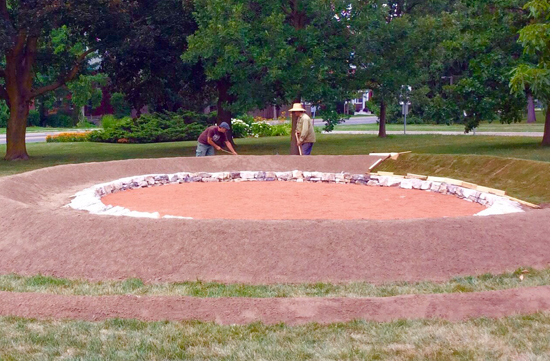It has been more than a year after the Truth and Reconciliation Commission’s report, which included 94 Calls to Action to address the relationship between indigenous and non-indigenous Canadians, was published. It seems that little has changed. We now gear up to celebrate the 150th anniversary of Confederation, a hugely colonial celebration hot on the heels of the Truth and Reconciliation Commission’s recommendations. The Art Gallery of Guelph (AGG), with over 40 years of developing strong relationships with First Nations artists, felt that it was important to undertake significant projects where they could first take part in a conversation about the issues raised by the Truth and Reconciliation Commission, and build a legitimate platform to bridge the conversation to Canada’s 150th celebration.
With this in mind, Dawn Owen, Curator of Contemporary Art at the AGG, commissioned local artist Don Russell to create the 39th permanent installation in the Donald Forster Sculpture Park. Owen and Russell envisioned a land work that would create the framework for a different type of engagement and experience in the sculpture park.
Don Russell grew up in the bayside community of Stephenville, Newfoundland. He identifies as Mi’kmaq (Qalipu Mi’kmaq First Nation, Newfoundland) and Acadian French. Russell lives and works in Cambridge, Ontario and maintains a studio at Boarding House Arts in downtown Guelph. Leaving Newfoundland greatly influenced Russell and instilled a deep connection with the land, which Russell explores through painting and sculpture.
Creating the Circle Mound was very process-based and developed slowly through numerous maquetes. Circle Mound has a central elevated mound and its burms, the raised mounds that extend from the centre to circle the main mound and reference the two rivers that flow through Guelph, draw the viewer in. The mounds are covered with long, plush grass, which leads up the mound to a ring of dark earth and dry-laid limestone stone, in the centre of which is a rich red clay circle.
The limestone was reclaimed from the Petrie Building in downtown Guelph. Russell noted, “The stone has an interesting story, as stone always does.” He chose each piece, which was shaped and dry-laid by a craftsman. Many of the limestone pieces are slightly blackened from fire, some were shaped for their previous uses, but all show signs of their previous lives before being returned to the earth as a part of Circle Mound.
Russell explained that he wanted to acknowledge and pay tribute to the history of the indigenous people in the region, while keeping the work accessible to the nonindigenous community. The circle is an important symbol for many First Nation peoples, speaking to concepts of time and spirituality. The installation will become a place for the community to gather. Russell noted, “Within the circle of the mound there is an intimacy, it’s a contemplative space.” Russell has worked to create a place where the community can connect with one another and the earth.
At the same time that the Circle Mound project began to develop, Owen and the AGG were approached to take part in The Mush Hole Project, an immersive, site-specific art and performance installation event. The Mush Hole Project takes place at the Woodland Cultural Centre in Brantford, which was previously the Mohawk Institute Indian Residential School. ‘The project aims to respond to the Truth and Reconciliation Commission of Canada’s Calls to Action and to preserve, query, and reveal the complex personal, political, and public narratives around Canada’s residential school system.’

Through the development of the project the parallels between the AGG, previously the Macdonald Stewart Art Centre, and the Woodland Cultural Centre, previously the Mohawk Institute, were striking. The Mohawk Institute was the oldest residential school in Ontario. The two previous iterations of the building burnt down through its history and what stands now was built in 1904, the same year that the Macdonald Stewart building was constructed as the Macdonald Consolidated School. The two buildings share a similar red brick façade, white column porch, and almost identical footprints.
However, one was crafted for the systematic assimilation of the First Nations peoples, while the other was, in effect, one of the first public schools in Ontario. The children at the Macdonald School were not removed from their families and communities; they were not disenfranchised from their culture, or told the languages they spoke were unacceptable.
The parallel histories continued, as the Mohawk Institute was closed in the 1970s to become the Woodland Cultural Centre, the Macdonald School was closed and repurposed into an art gallery. Both organizations have come to identify art as a priority for their communities and are now working together to make The Mush Hole Project a reality.
The Mush Hole Project has been embraced as a place to begin an important conversation around Truth and Reconciliation and the horrors of residential schools. Art has the power to explore these complex issues in a way that educates, acknowledges, and sets the stage for contemporary dialogue. It creates a place to give indigenous and nonindigenous people access, agency, and a voice in the conversation around Truth and Reconciliation and residential schools.
Through The Mush Hole Project a framework is created to continue conversations and continue building on Truth and Reconciliation while turning to the future. Moving into Canada’s 150th, Owen feels, “We can be critical and celebratory at the same time.”
Guelph is a community ready to face the challenges of these complex issues. Owen notes, “I think Guelph will embrace these ideas and then help to shape the next phase … We don’t know what the journey will be, but we’ve built a platform on which the conversation can happen.”
Circle Mound will be unveiled at the Art Gallery of Guelph on Thursday, September 15 at 7 pm, more information here. The unveiling of the sculpture will also launch the Mush Hole Project. The Mush Hole Project is an immersive, site-specific art and performance installation event taking place at the Woodland Cultural Centre in Brantford on September 16, 17 and 18, 2016. Find more information about The Mush Hole Project and to register for a tour here. Free bus transportation will be available from the University of Waterloo & Art Gallery of Guelph.








